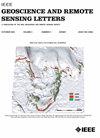Infrared Small Target Tracking via Gaussian Curvature-Based Compressive Convolution Feature Extraction
IF 4
3区 地球科学
Q2 ENGINEERING, ELECTRICAL & ELECTRONIC
引用次数: 15
Abstract
The precision of infrared (IR) small target tracking is seriously limited due to lack of texture information and interference of background clutter. The key issue of robust tracking is to exploit generic feature representations of IR small targets under different types of background. In this letter, we present a new IR small target tracking method via compressive convolution feature (CCF) extraction. First, a Gaussian curvature-based feature map is calculated to suppress clutters so that the contrast between target and background can be obviously improved. Then, a three-layer compressive convolutional network, which consists of a simple layer, a compressive layer, and a complex layer, is designed to represent each candidate target by a CCF vector. Based on the proposed mechanism of feature extraction, a support vector machine (SVM) classifier with continuous probabilistic output is trained to compute the likelihood probability of each candidate. Finally, the long-term tracking for IR small target is implemented under the framework of the inverse sparse representation-based particle filter. Both qualitative and quantitative experiments based on real IR sequences verify that our method can achieve more satisfactory performances in terms of precision and robustness compared with other typical visual trackers.基于高斯曲率压缩卷积特征提取的红外小目标跟踪
由于纹理信息的缺乏和背景杂波的干扰,严重限制了红外小目标跟踪的精度。鲁棒跟踪的关键问题是利用不同背景下红外小目标的通用特征表示。本文提出了一种基于压缩卷积特征(CCF)提取的红外小目标跟踪方法。首先,计算基于高斯曲率的特征映射来抑制杂波,从而明显提高目标与背景的对比度;然后,设计了一个由简单层、压缩层和复杂层组成的三层压缩卷积网络,用CCF向量表示每个候选目标。基于所提出的特征提取机制,训练具有连续概率输出的支持向量机(SVM)分类器,计算每个候选对象的似然概率。最后,在基于逆稀疏表示的粒子滤波框架下实现了红外小目标的长期跟踪。基于真实红外序列的定性和定量实验表明,与其他典型的视觉跟踪器相比,我们的方法在精度和鲁棒性方面都取得了令人满意的效果。
本文章由计算机程序翻译,如有差异,请以英文原文为准。
求助全文
约1分钟内获得全文
求助全文
来源期刊

IEEE Geoscience and Remote Sensing Letters
工程技术-地球化学与地球物理
CiteScore
7.60
自引率
12.50%
发文量
1113
审稿时长
3.4 months
期刊介绍:
IEEE Geoscience and Remote Sensing Letters (GRSL) is a monthly publication for short papers (maximum length 5 pages) addressing new ideas and formative concepts in remote sensing as well as important new and timely results and concepts. Papers should relate to the theory, concepts and techniques of science and engineering as applied to sensing the earth, oceans, atmosphere, and space, and the processing, interpretation, and dissemination of this information. The technical content of papers must be both new and significant. Experimental data must be complete and include sufficient description of experimental apparatus, methods, and relevant experimental conditions. GRSL encourages the incorporation of "extended objects" or "multimedia" such as animations to enhance the shorter papers.
 求助内容:
求助内容: 应助结果提醒方式:
应助结果提醒方式:


